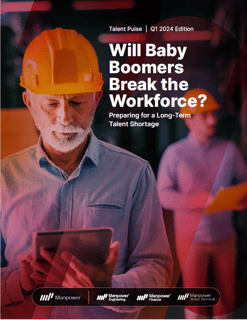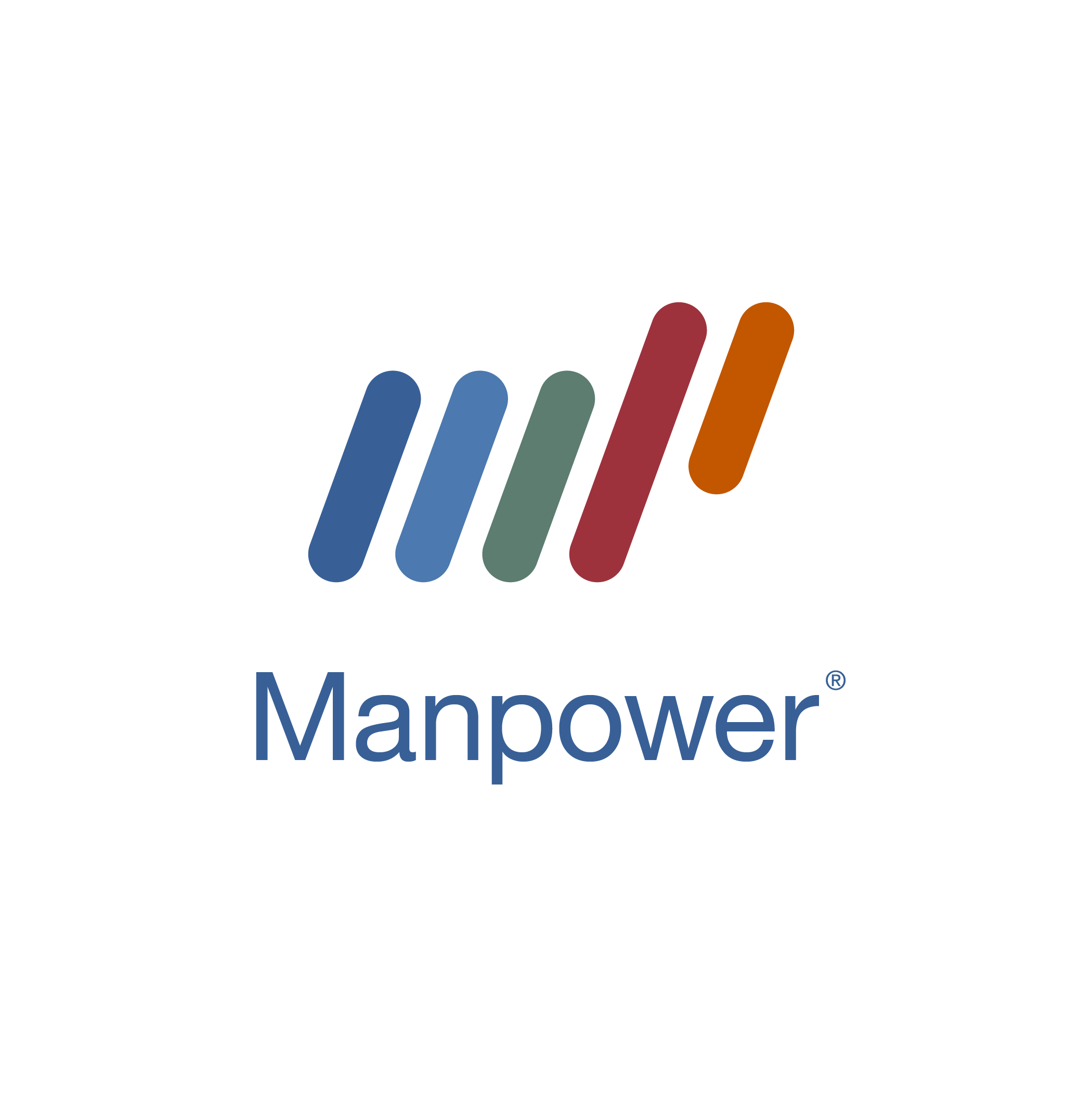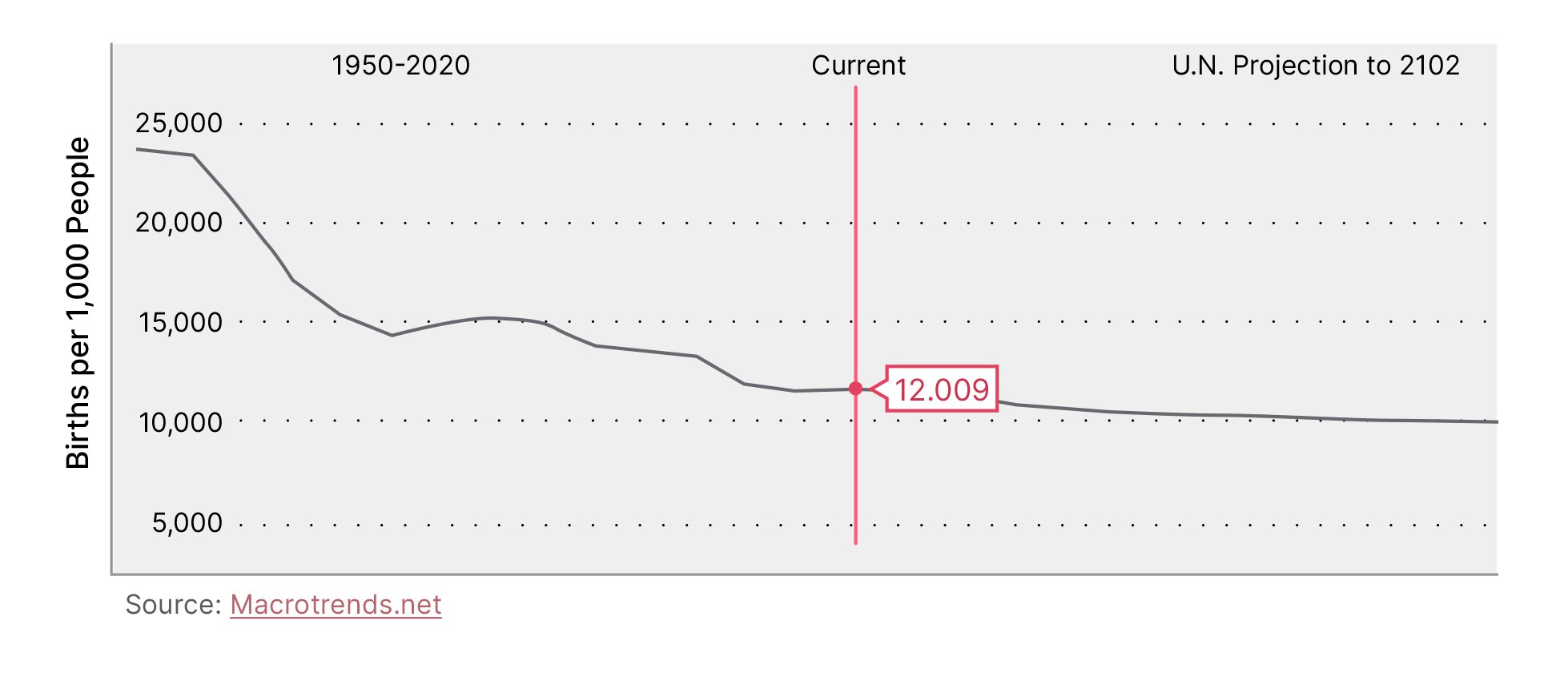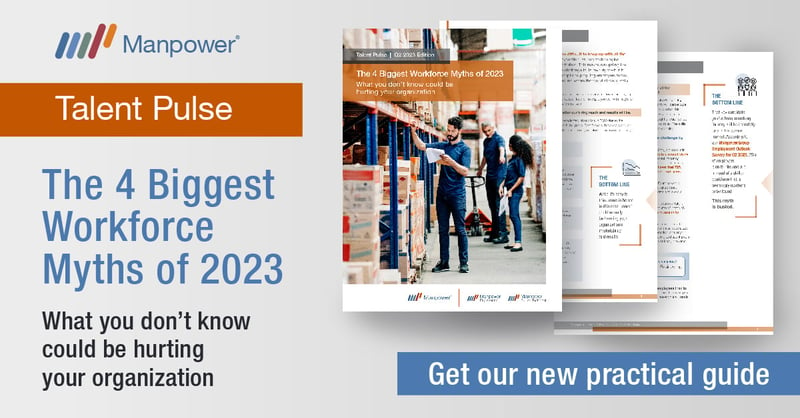
|
If you prefer, you can download the PDF of this Talent Pulse Briefing. |
Profile of the American Workforce
We saw it coming---and now it's happening. The baby boomers are riding off into the sunset, and the workforce will never be the same. Sound dramatic? Like that action movie where the cop on the cusp of retirement is called back to do "one last job"?
This is one time the action movie gets it right. But more on that later.
.png?width=2104&height=999&name=Page2%20MP_TalentPulse_Q1-24-image%20(1).png)
1.https://www.nber.org/system/files/working_papers/w26633/w26633.pdf 2. https://www.census.gov/library/stories/2023/05/2020-census-united-states-older-population-grew.html
3. https://www.cbsnews.com/news/retirement-medicare-401k-what-to-know-peak-65/ 4. https://www.cbsnews.com/news/senior-citizens-1-in-5-still-work-pew-research/
And while the baby boomers, the largest generation in U.S. history, are leaving the workforce, the number of workers (of any age) entering the workforce has remained flat for the last two decades.
Simply put, the worker replacement rate is quite unbalanced and that is going to place added pressure on an already complex situation.
The math doesn't lie (though in this scenario we wish it would). The current US birth rate is roughly half of what it was in 1950.
What's an employer to do?
The good news is, there are concrete steps you can take. Starting now.
1. Hire mature workers
65 is just a number. Due to many advances in science and medicine, Americans are living longer. When the retirement age was set at 65 back in the 1930s, average life expectancy was 62 years. Today, it is 79 years, and expected to climb.
- Many people in their 60s and 70s (and beyond) are in perfectly good health and see no reason to retire. Many also fear they may outlive their savings if they retire too early.
- Don't fall for the myth that mature workers cost more. Research shows that workers over 50 years old are 5 times less likely to change jobs compared to people 20-24. This lower turnover rate translates to big savings on recruitment. They also take approximately the same number of sick days as younger workers.
- Some research is showing that mature worker are more productive. According to Gallup poll, baby boomers are the least stressed and most engaged of any age group. This may be because they've arrived at the place they want to be in their career.
- Worried about baby boomers being tech-savvy? Spurred in part by the need to work digitally during the pandemic, adoption of key technologies by those in the oldest age group has grown markedly since about a decade ago, according to Pew Research conducted in 2021. The gap between the oldest and youngest adults narrowed and continues to narrow.
2. Build inter-generational bridges for knowledge transfer
While you have those baby boomers on the payroll, it's time to formalize the process of knowledge transfer, so your workforce doesn't lose a generation's worth of expertise. If in doubt about the depth and breadth of your mature workers' knowledge, consider leveraging assessments or surveys. Then, develop a strategy that may include:

Retain, don't retire
To do more to retain the wisdom of their mature employees, many organizations have developed new ways of working.
For example, some organizations offer a detailed phased retirement program. At NASA, retirement-eligible employees can work half-time for up to two years and earn partial retirement benefits before transitioning to full retirement. At least 20% of the program participant's work hours must consist of mentoring and knowledge-sharing activities, including direct mentoring of successors or other staff, developing and/or presenting training, and developing policies and operating processes.
At Cochlear, a global medical device company headquartered near Denver, employees are encouraged to apply for temporary, three-to-six month assignments in other departments or offices that needs additional help. These assignments have proven to be very popular with late-career employees.
And CVS Health has an innovative “snowbird” program that encourages employees in cold climates to transfer to stores in warmer locations for the winter months. This gives workers the flexibility they want and provides the company with much-needed additional seasonal help.
How to make it work:

Capitalize on Millennials' desire to advance in the organization. Millennials recognize the expertise of baby boomers, and they know that learning from them will fuel the new opportunities they seek.

Tie knowledge-transfer opportunities to the larger mission of the organization, which is something Millennials want to be part of.

Foster a give-and-take ecosystem by looking for opportunities for Millennials to share technical knowledge with baby boomers.

Capitalize on Baby Boomers’ desire to contribute. According to Dr. Linda Fried, director of Columbia’s Age Boom Academy and the Robert N. Butler Columbia Aging Center, “As people get older, maybe because of their problem-solving capabilities plus a huge dose of generativity, [they want] to leave things better for subsequent generations.”

Formalize knowledge transfer by setting up a succession plan. Succession planning ensures that businesses continue to run smoothly and without interruption after leaders retire or move on to new opportunities. A good succession plan should include cross-training, with mature workers as mentors.
3. Get started ASAP!
Suffice to say that with 11,000 baby boomers reaching retirement age every day, you need a solid plan for securing your organization’s future.
.png?width=1139&height=830&name=Last%20Page%20MP_TalentPulse_Q1-24-image%20(2).png) 5. https://fortune.com/well/2024/01/26/benefits-older-employees-workforce-retention-burnout-experience-inclusivity/ 6. https://press.aarp.org/2021-9-29-AARP-Launches-Skill-Building-Platform-to-Help-Older-Workers-Compete-in-Todays-Job-Marke 7. https://go.manpowergroup.us/mature-workers
5. https://fortune.com/well/2024/01/26/benefits-older-employees-workforce-retention-burnout-experience-inclusivity/ 6. https://press.aarp.org/2021-9-29-AARP-Launches-Skill-Building-Platform-to-Help-Older-Workers-Compete-in-Todays-Job-Marke 7. https://go.manpowergroup.us/mature-workers
For information on all the ways we can help, connect with your Manpower workforce expert today.







Comments